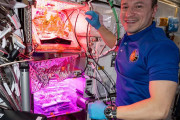 2024-04-08
2024-04-08
Astronaut Andrew Morgan waters plants in the Veg-04B experiment on the space station. This space botany research is one of several studies into how to provide fresh food for crews on long-term space missions. Credits: NASA NASA’s exploration requires research into how light affects both humans and plants: John Glenn’s first trip into Earth orbit lasted just under five hours, but today, astronauts regularly stay six months or longer on the International Space Station. Experiencing over a dozen sunrises and sunsets each day means an astronaut’...
Continue reading →
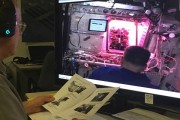 2016-12-09
2016-12-09
For a mid-afternoon snack, NASA astronaut Shane Kimbrough cut some of the "Outredgeous" Red Romaine lettuce leaves he nurtured during the past month aboard the International Space Station as part of a gardening harvest technique termed “cut-and-come-again.”
Continue reading →
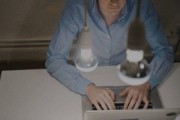 2016-04-20
2016-04-20
It’s a cruel daily cycle. We get drowsy when it’s time for that big meeting, but are suddenly wide awake when it’s time to hit the hay. But did you ever think that swapping your light bulbs might be the solution? The researchers at Lighting Science Group have been studying the effects of different kinds of light on our sleep and awake cycles since they developed light therapy products for NASA astronauts, and have extended their findings to create a line of LED bulbs engineered to restore our natural circadian rhythms. Inhabitat recently checked out LSG’s HealthE biological light line, which includes an Awake and Alert bulb that promotes energy and cognitive abilities, a Good Night bulb that supports the body’s natural creation of melatonin for corrected sleep patterns, and the Sleepy Baby bulb that creates the perception of darkness to help babies fall asleep. Read on to see what we learned.
Continue reading →
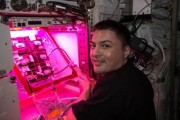 2016-01-20
2016-01-20
One of the most triumphant moments in the book and recent movie The Martian comes when lead character, Mark Watney, successfully grows a potato crop on Mars. It’s more than food for survival; he’s also nourishing his spirit. In space, there is no scent of baking bread, no wind on your face, no sound of raindrops hitting the roof, no favorite kitten to curl up in your lap. Over time, being deprived of these common earthbound sense stimulations takes a toll. Having limited access to stimuli to the senses is identified as a significant risk by NASA’sBehavioral Health and Performance team.
Continue reading →
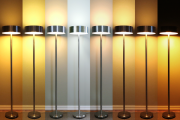 2015-11-05
2015-11-05
Here comes a research-backed healthy smart LED lamp, the Ario lamp. The company founded by a group of former Microsoft employees and many other engineers launched its campaign on Kickstarter, setting out to raise US $50,000. Unsurprisingly, with its design backed by research of NASA and Harvard Medical School, the campaign has successfully reached its goal within 24 hours.
Continue reading →
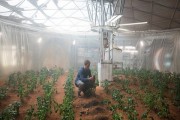 2015-10-02
2015-10-02
Stranded on the barren red planet Mars with few supplies available, astronaut Mark Watney played by Hollywood actor Matt Damon in The Martian is fighting for survival on the harsh planet.
Continue reading →
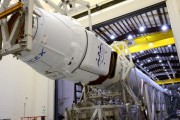 2015-08-10
2015-08-10
Jay Kim, Head of Marketing and Business Development Head of Marketing and Business Development at Business Center OLED, Philips’ OLED lighting division shares in this blog entry how OLEDs are making their ways into outer space and everyday lighting applications.
Continue reading →
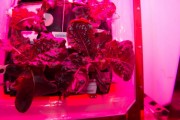 2015-08-10
2015-08-10
Fresh food grown in the microgravity environment of space officially is on the menu for the first time for NASA astronauts on the International Space Station. Expedition 44 crew members, including NASA's one-year astronaut Scott Kelly, are ready to sample the fruits of their labor after harvesting a crop of "Outredgeous" red romaine lettuce Monday, Aug. 10, from the Veggie plant growth system on the nation’s orbiting laboratory.
Continue reading →
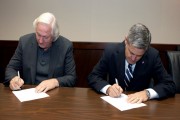 2015-07-31
2015-07-31
NASA at the Kennedy Space Center has entered into a partnership with Light Visually Transceiving (LVX) System Corp. to collaborate in developing a potentially ground-breaking technology in electronic communications. Similar to high-speed communication known as Wi-Fi, visible light communication, or VLC, is a wireless method using light-emitting diodes referred to as Li-Fi.
Continue reading →
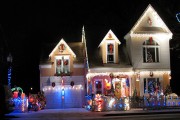 2014-12-22
2014-12-22
Even from space, holidays shine bright. With a new look at daily data from the NOAA/NASA Suomi National Polar-orbiting Partnership (Suomi NPP) satellite, a NASA scientist and colleagues have identified how patterns in nighttime light intensity change during major holiday seasons – Christmas and New Year's in the United States and the holy month of Ramadan in the Middle East.
Continue reading →
2014-12-15
Lighting Science Group Corporation (OTCQB: LSCG) announced today that their innovative GOOD NIGHT™ and AWAKE AND ALERT™ lamps were recently featured in Consumer Reports magazine. The article goes behind the science of our lamps and their link to NASA and the International Space Station astronauts. A focus on the importance of blue light technology and how it affects human circadian rhythm was key in the development of these revolutionary products.
Continue reading →
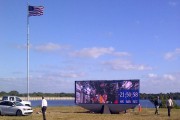 2014-12-04
2014-12-04
The new generation of human space exploration spacecraft is getting a new generation clock to count it down for launch on December 4.
Continue reading →
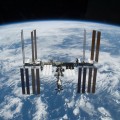 2012-12-18
2012-12-18
NASA's planning a test to replace fluorescent lighting panels in the ISS with a solid-state LED lighting module which produces blue, white, or reddish light depending on the time. It hopes that this change will serve as a counter-measure to the inevitable disruption of the body's circadian rhythm while in space — this would hopefully reduce insomnia, which can have a host of deleterious effects while in space. Sleep in space has long been a concern for NASA — back in 2001, a study showed that 50 percent of some Space Shuttle crews relied on medicat...
Continue reading →
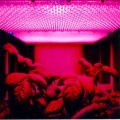 2012-09-04
2012-09-04
The future of further human deep space exploration is dependent on the development of many new systems and technologies. And researchers have considered that nuclear-powered state of the art LED technology is “what will drive (the) photosynthesis so necessary to provide both food and oxygen for future lunar colonists.” “Future long-term lunar residents will need to grow their food either in sub-lunar lava tubes or in greenhouses shielded with several meters of lunar surface regolith. With no atmosphere, the moon is regularly exposed to lethal doses of cosmic rays,...
Continue reading →
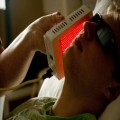 2011-03-08
2011-03-08
Lately, the NASA technology has utilized LED technology (turned medical device) in the Bone Marrow Transplant and Cellular Unit at a hospital at the University of Alabama.
This technology is being used to ease the pain of mouth and throat sores, common side effects of chemotherapy and radiation treatment.
According to NASA, a far red/near infrared Light Emitting Diode treatment called High Emissivity Aluminiferous Luminescent Substrate has been given to ease the pain of cancer patients.
With a system called Warp 75, the LEDs release energy in the for...
Continue reading →
2009-11-20
Lighting Science Group Corporation (LSG), a global leader in LED lighting products and the NASA John F. Kennedy Space Center Thursday have signed a two year agreement to jointly develop a high illumination and good color rendering LED light fixture for space exploration.
Continue reading →
 2016-12-09
2016-12-09
 2016-04-20
2016-04-20
 2016-01-20
2016-01-20
 2015-11-05
2015-11-05
 2015-10-02
2015-10-02
 2015-08-10
2015-08-10
 2015-08-10
2015-08-10
 2015-07-31
2015-07-31
 2014-12-22
2014-12-22
 2014-12-04
2014-12-04
 2012-12-18
2012-12-18
 2012-09-04
2012-09-04
 2011-03-08
2011-03-08